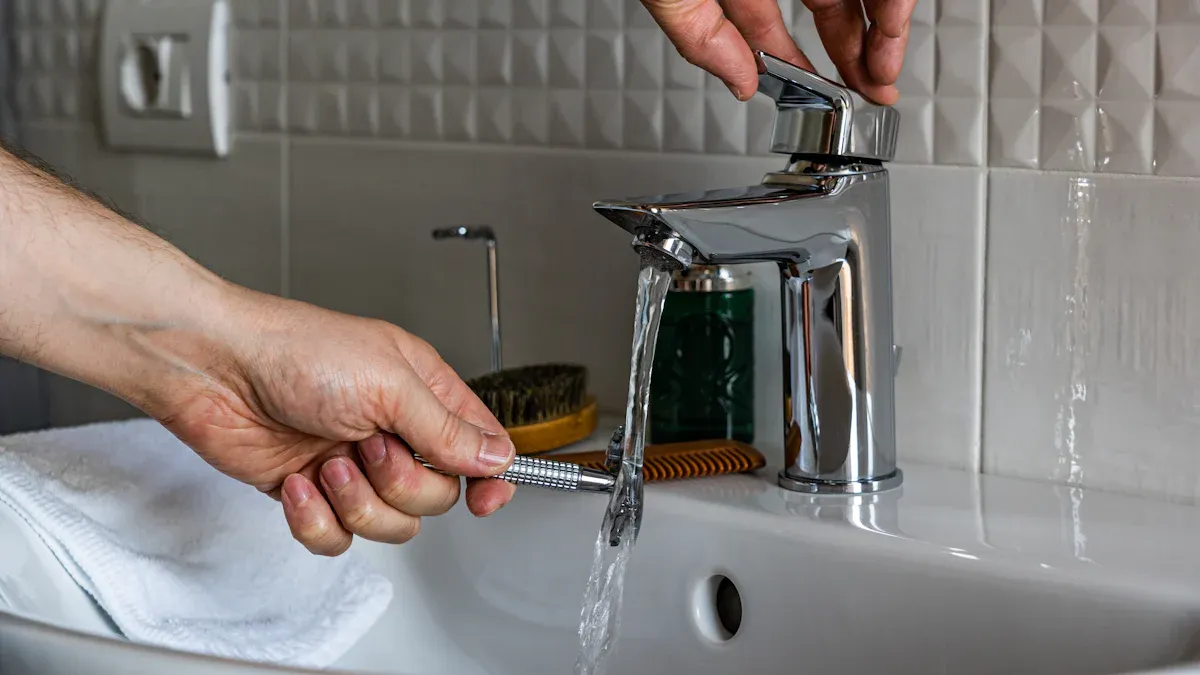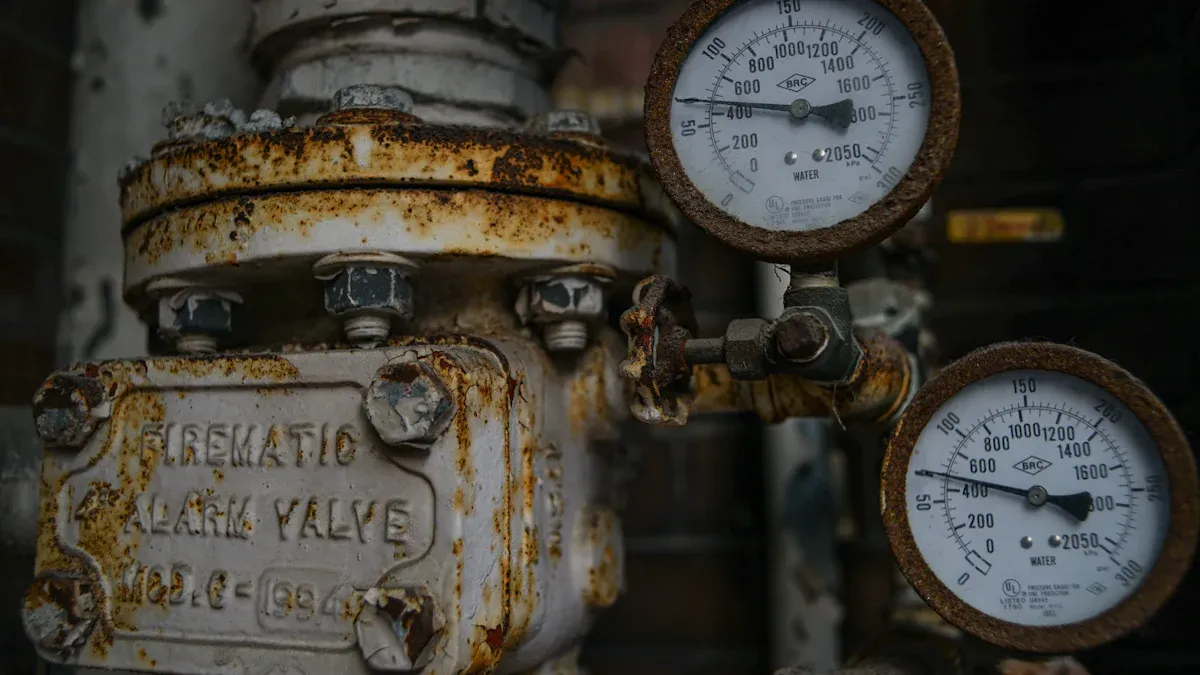
 FEEDBACK
FEEDBACK
If you are interested in our products and want to know more details, please leave a message here, we will reply you as soon as possible.


You wake up and want a nice shower, but the water is weak. Many people have low water pressure in their bathrooms. This can make sinks fill slowly. Showers may spray weakly. Faucets can also be slow.
Sometimes, only one fixture has this problem.
Clogged aerators or hidden leaks often cause these problems.
Mineral buildup and partly closed valves can make it worse.
Modern, high-quality fixtures like stainless steel bathroom cabinets help make your bathroom better. They also resist problems from moisture and rust.
When you notice low water pressure in your bathroom, you need to find out if the problem is only in one place or if it affects your whole home. This step helps you save time and avoid unnecessary repairs.
Start by checking other rooms in your house. Turn on the kitchen faucet, laundry tap, and any outdoor spigots. If you see weak flow in all these places, the issue may be with your main water supply or the pressure regulator. If only the bathroom has low water pressure, the problem is likely local.
Here is a simple way to check:
Test water pressure at several fixtures around your home.
Use a water pressure gauge on an outdoor faucet. Normal pressure should be between 40 and 60 PSI.
Ask your neighbors if they have similar issues. If they do, the problem might be with the city’s water supply.
Watch for changes when appliances like dishwashers or washing machines run. Sometimes, using many fixtures at once can lower pressure.
Tip: If you find low water pressure everywhere, you may need to call your water provider or a plumber.
Next, check if the problem affects both hot and cold water. Turn on the bathroom sink and shower. Try both hot and cold settings.
If only the hot water has low pressure, the issue could be with your water heater or its pipes.
If both hot and cold have weak flow, look for clogs or closed valves near the fixture.
Remove the faucet aerator or showerhead and check for debris or mineral buildup.
By testing other rooms and comparing hot and cold water, you can quickly narrow down the cause of low water pressure. This makes it easier to fix the problem and restore normal flow.

If your bathroom water is weak, you should know why. Many things can make water flow slow. Plumbers often see these problems:
Valves under sinks or near machines are not fully open.
Pipes have blockages or leaks that stop water.
Fixtures like faucets or shower valves are broken or old.
Pipes can rust or get blocked, mostly in older houses.
Leaks can happen inside the plumbing system.
Pressure regulators might not work right.
Fixtures and valves may be old and worn out.
Cold weather or lots of people using water can cause issues.
Aerators are at the end of your faucet. They mix air and water to control flow. Minerals and dirt can block these screens over time. This happens more in places with hard water. When aerators clog, water cannot move well. You might see a weak or uneven spray.
Tip: Take off the aerator and put it in vinegar. Use a toothpick to poke out dirt. Clean aerators often to stop low water pressure.
Cleaning often keeps your fixtures working well. If you see buildup, clean or change the aerator. This easy step can bring back normal water pressure.
Valves let water move to your bathroom. After repairs, valves might not be fully open. Even a little closed valve can lower water pressure. Main shutoff, street, or sink valves all matter.
Make sure every valve is open all the way. Turn the handle left until it stops. If a valve is not open, fix it and check the water again.
Note: Valves that are not open are a common reason for low water pressure. Always check valves before trying harder fixes.
Supply lines carry water to your faucets and shower. If these lines bend too much or get pinched, water slows down. Dirt or minerals inside the line can also block water. Both problems make water pressure low.
Look at the supply lines under your sink or behind the cabinet. Check for sharp bends or kinks. Straighten the lines if you need to. If you see a blockage, you may need a new line.
Doing regular checks helps stop these problems. Clean fixtures, check valves, and look at supply lines once a year.
Good fixtures, like Langdeng stainless steel bathroom cabinets, help water flow well. Stainless steel does not rust or get damaged by water. This keeps your plumbing in good shape. You get strong water pressure for a long time.

You should start by looking at all the pipes you can see in your bathroom. Pipes under the sink, behind the toilet, and near the shower are easy to check. Look for rust, green stains, or bulging spots on the pipes. These signs often mean corrosion or leaks. If you see water stains, wet spots, or crystal-like deposits on valves, you may have a leak. Sometimes, you will notice broken or frayed strands on braided stainless-steel supply lines. These problems can lead to low water pressure and even bigger plumbing issues.
Check for:
Rust or discoloration on pipes
Bulging or unusual textures
Crystal-like deposits on brass valves
Cracks or discoloration on plastic pipes
Water stains or damp spots near joints
Tip: Use a flashlight to look behind cabinets or under sinks. Even small leaks can cause big problems over time.
You can also check your water meter. Turn off all water in your home. Write down the meter reading. Wait for an hour without using water. If the number goes up, you likely have a hidden leak. For toilets, add a few drops of food coloring to the tank. If color appears in the bowl, the tank leaks.
Water damage often shows up before you see a leak. Watch for stains on walls, ceilings, or floors. These stains are usually yellow, brown, or copper-colored. Peeling paint, bubbling wallpaper, or soft drywall are signs of moisture behind surfaces. Mold or mildew can grow on walls and ceilings if leaks go unnoticed. You might also smell musty odors near cabinets or closets.
Signs of water damage:
Mold or mildew growth
Musty, foul odors
Damp or swollen cabinets
Spongy or loose floor tiles
Peeling paint or wallpaper
Note: Fixing leaks quickly saves water and prevents damage. Even small leaks can waste thousands of gallons each year and raise your water bill.
Regular inspections help you catch leaks early. High-quality fixtures, like Langdeng stainless steel bathroom cabinets, resist moisture and corrosion. This helps protect your bathroom from water damage and keeps everything looking new.
You can often fix low water pressure by cleaning or replacing the aerator on your faucet. The aerator is a small screen at the tip of the faucet. Over time, minerals and dirt can block it. Here is how you can clean or replace it:
Unscrew the aerator by turning it counterclockwise. Use pliers if it feels stuck.
Take apart the aerator and remember the order of the pieces.
Soak the parts in white vinegar for a few hours. This helps dissolve mineral deposits.
Use an old toothbrush to scrub away any buildup. A toothpick can help clear small holes.
Put the aerator back together and screw it onto the faucet.
Turn on the water and check the flow. If the pressure is still low, you may need a new aerator.
Tip: Clean your aerators every six months, especially if you live in an area with hard water.
Sometimes, low water pressure happens because a valve is not fully open. You should check all the valves in your bathroom and home.
Check the valves under your sink and behind your toilet.
If you have a water heater, turn it off before opening valves to protect it.
Open several faucets to let out any trapped air. This can stop water from spurting.
After opening the valves, look for leaks around your pipes.
Note: Always unplug appliances like washing machines before working on water lines.
Kinked or bent supply lines can slow down water flow. You can fix this problem with a few simple tools.
Use a long, sturdy pipe to gently straighten the supply line.
Slide the pipe over the bent line and use it as a lever.
Insert a wooden dowel inside the line to keep it from kinking while you work.
Check that the supply lines run straight from the wall to your faucet or toilet. If you see sharp bends, straighten them to help restore normal water pressure.
A faulty cartridge inside your faucet can also cause low water pressure. You might notice trouble adjusting the water temperature or weak flow even when other fixtures work well.
Remove the faucet handle by unscrewing it.
Take out the old cartridge. You may need to remove a cap or nut first.
Buy a new cartridge that matches your faucet.
Install the new cartridge and put the faucet back together.
Turn the water back on and test the flow.
If you are not sure which cartridge to buy, check the brand’s website or ask at a hardware store.
If you follow these steps, you can solve most low water pressure problems in your bathroom.
Sometimes, you try every fix, but the water pressure stays low. This is a sign that you need help from a professional plumber. You might notice weak water flow in more than one bathroom or even throughout your whole house. Toilets may flush slowly. Showers might only trickle. These problems often point to bigger issues inside your plumbing.
Here are some warning signs that tell you it is time to call a plumber:
Slow flushing toilets
Water leaks or wet spots on walls or floors
Rusty or discolored water
You may have hidden leaks, pipe corrosion, or mineral buildup deep in your pipes. These problems can get worse if you wait. Early attention from a plumber can stop small issues from turning into expensive repairs. Plumbers have special tools to find leaks and blockages that you cannot see. They can also check for burst pipes or broken sewer lines, which need fast repairs.
Tip: If you see water stains, mold, or hear dripping sounds behind walls, call a plumber right away. Quick action protects your home from water damage.
Low water pressure in every room often means trouble with your main water line or the pressure regulator. These parts control how much water flows into your home. When they fail, you need a professional to fix them.
Common main line or regulator problems include:
Blockages: Mineral deposits can build up inside the pressure regulator valve. This blocks water and lowers pressure. Plumbers can clean or replace these parts.
Damaged Internal Components: Parts inside the regulator, like the diaphragm or spring, wear out over time. Old parts make the valve less effective. Replacement is usually the best fix.
Incorrect Pressure Setting: The regulator has a screw that sets the water pressure. If set too low, your whole house will have weak flow. A plumber can adjust this setting for you.
You should not try to repair main lines or regulators yourself. These jobs require special skills and tools. A professional will restore safe, steady water pressure and help prevent future problems.
You can fix most low water pressure problems with a few steps. First, look at the water pressure regulator and check both hot and cold water lines. Next, clean or change clogged aerators and old fixtures. Also, look for leaks or rust on pipes you can see. Try these easy fixes before calling for help. Doing it yourself saves money and teaches you new things. If the problem does not go away or seems hard, call a plumber. Getting new fixtures, like Langdeng stainless steel bathroom cabinets, keeps your bathroom working well and looking nice.
You often see this when a clogged aerator, a closed valve, or a kinked supply line blocks water flow. Check these parts first. If you fix them and the problem stays, you may have a leak or a faulty fixture.
Use a water pressure gauge on an outdoor faucet. Normal pressure reads between 40 and 60 PSI. If your reading falls below this range, you likely have low water pressure.
Stainless steel cabinets, like those from Langdeng, do not directly change water pressure. They resist moisture and corrosion. This helps protect your plumbing and fixtures, which supports long-term water flow.
Yes, you should clean aerators every six months.
Regular cleaning removes mineral buildup.
This keeps water flowing strong and steady.
Situation | Action |
|---|---|
All rooms have low flow | Call a plumber |
You see leaks or stains | Call a plumber |
DIY fixes do not work | Call a plumber |
Quick help prevents bigger plumbing problems.